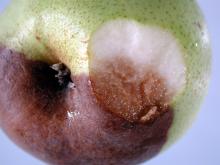See:
Apple (Malus spp.) - Fruit Rot, Phytophthora
Pear (Pyrus spp.) - Storage Rots
Cause Phytophthora spp., a soilborne fungus-like microorganism frequently carried in irrigation water. There were 9 different distinct taxa of Phytophthora pathogenic to pear found in irrigation water canals in north central Washington. Fruit rot has caused significant loss of fruit where irrigation water wetted fruit, usually on lower branches or from overhead irrigation for summer fruit cooling. As little as 1 hour of fruit wetting is enough time for infection.
Symptoms Firm, tan-colored, rotted spots on areas up to more than 1 inch in diameter on the fruit. Older infections can cause the whole fruit to rot on the tree. Can be confused with fire blight on immature pears but is lighter in color and soft to the touch. Some years, disease also may spread to fruit pedicels and a little way into first-year wood, causing a dieback that resembles fire blight.
Cultural control
- Use low-angle or microsprinkler heads, that do not let water wet fruit, under trees. Drip irrigation can also be used.
- Reduce the length of irrigation sets.
Chemical control Copper metered into water at 1 part per million. Higher concentrations will russet 'Anjou' pears.
Reference Yamak, F., Peever, T.K., Grove, G.C., and Boal, R.J. 2002. Occurrence and identification of Phytophthora spp. pathogenic to pear fruit in irrigation water in the Wenatchee River Valley of Washington state. Phytopathology 92:1210-1217.


